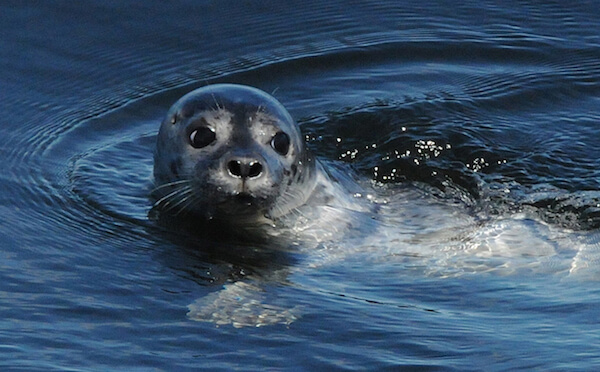Do you see what I see? Between the frigid winds, snow squalls and ice floes forming on the St. Lawrence, it’s not always easy to clearly discern the marine species that have either taken up residence or are passing through this maritime gateway.
Whales, anyone?
This week, whale sightings have been sparse, but not absent! Despite the strong winds hampering visibility, observers on board the pilots’ boat spotted the breath of a minke whale off Les Escoumins. A little farther east on the North Shore, a resident also happened to look at the water at just the right time: “There is generally too much ice for whales to approach the shore, but I did see a humpback pass by off the coast of Franquelin on Sunday,” he exclaims.
Seals
Once again this week, seals have been appearing through the sea smoke – a veil of fog that can form when cold air moves over a body of warmer water. On Monday, mariner Jacques Gélineau tallied roughly 50 harp seals feeding near Sept-Îles. And, last weekend, about 100 harbour seals were in the Gaspé Bay area. “We’re starting to sporadically see seals on the ice, and we can’t wait for the whitecoats” tells an observer from the Magdalen Islands.
“Yesterday, the River was like a sheet of glass, as my father used to say. We had the pleasure of seeing a seal on a small chunk of ice that was resting and taking advantage of the break in the weather,” reports an observer from Franquelin on January 14.
I saw a seal, but what kind?
How can one distinguish the various species of seals that frequent the St. Lawrence and thereby refine one’s observations? Here are a couple of tips. If a seal is in the water, the shape of its head provides a good clue as to what species it is. Indeed, the head of the grey seal resembles that of a horse, whereas that of the harbour seal is more dog-like in appearance. The harp seal has an entirely black head.
When a seal lies on the pack ice, its entire body is visible, which makes it easier to identify and allows for excellent observations.
The size of the animal is also a good indicator of the species. Harp seals average 1.6 m in length and weigh between 130 and 150 kg. Grey seals are larger, measuring up to 2.3 m long and tipping the scales at over 300 kg. Harbour seals, which like belugas are year-round residents of the St. Lawrence Estuary, are of intermediate size and weigh the least. They reach an average of 1.85 m and usually weigh around 110 kg.
Do you enjoy scanning the waters every chance you get? Become an observer for Whales Online!
In order to continue to feed our “Observations of the Week” column, we need to recruit new volunteer observers who can relay to us their weekly encounters with marine mammals. More precisely, we are looking for individuals based in the Bas-Saint-Laurent region and downstream of Sept-Îles. Interested? Drop us a line at [email protected].








